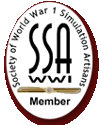

Contents:
Flawed
Beginning
History
Begins
Early UOP's
"The Dr.1 is Porked!"
SWWISA
The Last Classic UOP
To
the East!
Revolution
of CdT
A New Breed of UOP
Pat Wilson and WFP
Stachel's Hell's Angels
The Promised Land
The End of the Road
Flawed From
the Beginning
When Sierra-Dynamix released Red
Baron II in 1998, it was a flight simulation with many flaws. As a matter
of fact, one of the game’s producers called Red Baron “the example of
everything that shouldn’t be done when making a game”. The game
crashed regularly, flights of aircraft circled endlessly over their
airfields, and a host of other bugs plagued Red Baron II’s release.
Historical inaccuracies could be found everywhere, from the twin-bay DH2
(which is supposed to be single) to the misspelling of the ranks listed
for French pilots. Even the release of Red Baron 3D (also known as the 3D
Superpatch) did little to improve what was ultimately a disappointing
release. A world of work was needed just to make the game passable, let
alone be a success by historical and gameplay standards. However, a
community of enthusiasts and armchair flight historians who loved
everything World War I and the Red Baron, began to work on the game. Some
from this group even flew the original Red Baron I by Sierra in the early
1990’s, but all felt compelled to make Red baron II the best simulation
WWI possible, and history began.
History
Begins
Patching Red Baron, as it is commonly known, was a very crude undertaking at first. But community members like Sygrod began to spend hours unearthing Red Baron’s file system, compiling mountains of data that allowed modders to peer “under the hood” and see what, if anything could be changed. Patch makers began altering aircraft skins, terrain, and sound effects. It was a slow and tedious process as no one in the community had any idea how Red Baron’s file system was structured. However, with time, the blueprints behind the mysterious file system slowly became apparent. Little did anyone know, it was the beginning of what would become a long and impressive journey.

(Bitmap
File of Guynemer’s SPAD from the Beery 2.0 Patch)
As time progressed, so did the
quality of the files made, and the ability to alter how the game
functioned. By 1999, patch makers within the community had a rudimentary
idea of how to alter the flight model, damage model, sound effects, and
basic bitmap files which controlled individual aircraft appearance. The
door had been opened, and the efforts to improve Red Baron II had begun in
earnest. Soon the advent of the UnOfficial Patch, or UOP began to take
shape. These patches attempted to compile many improvements to several
aspects of the game into one cohesive file that end-users could download
and install.
Almost six years later, we have reached the end of the perceivable road for the venerable Red Baron. While it is impossible to document every improvement made by every individual in the community, there are works that stand the test of time, broke new ground in the community, and are deserving of historical documentation within the community. One can look at the progression of UnOfficial Patches and clearly see the road of development that the game took and where it ultimately led.